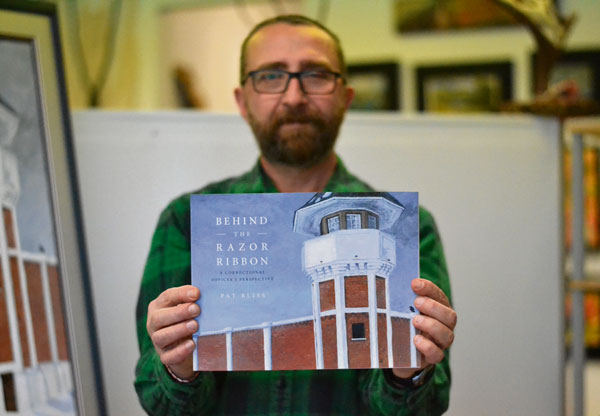
“It just dawned on me—nobody’s ever told our story.”
Prince Albert’s Pat Bliss used to drive by the Saskatchewan Penitentiary, take a glimpse at the razor ribbon lining the chain link fence and think ‘Wouldn’t want to get caught in that.’
During his 27 years working as a correctional officer there, several inmates tried to escape the grounds—It was nearly impossible to get over the fence without getting cut from the barbs.
Bliss is exposing what correctional officers face on a daily basis in his artwork: death threats, homemade weapons, the fear of infections and PTSD. Despite some traumatic experiences, he inspires others in similar situations to remember who you are when you step out from behind the walls.
Bliss has compiled his artwork about his time working at the Penitentiary in Behind the Razor Ribbon: A Correctional Officer’s Perspective. The book was published last month, and contains 29 pieces about his experiences.
“I was reading an article in one of the art magazines I was getting about prison art and I thought ‘Oh, this is interesting. It’s all about inmate art,’ and it just dawned on me—nobody’s ever told our story,” he said.

Bliss never intended to create a full body of work dedicated to the topic. He figured he’d start with one or two, but it “snowballed” into more and more.
“Since I started working at the Pen, I was always very discouraged by the way we were portrayed in movies and the press…Because correctional officers work in a closed environment, nobody really knows what we do and I wanted to portray to people what our job really was like,” he said.
Bliss said movies and television shows often portray correctional officers as “mindless thugs, bullies.” When incidents occur inside jails, he explained, media report on it to the public without knowing the full circumstances.
“There’s an awful lot of scrutiny on the officers,” he said. “Say if an inmate gets sick or dies in the middle of the night. Well, I’ve got 400 guys I’m checking on every 15 to 45 minutes to make sure they’re alive and well in the dark. All the sudden everything dumps on them: ‘How did you miss that?’”
In the 1980s, Bliss was working on his farm when he was struck with high interest rates and crop failure.
“I was at the point where I needed to find a different line of work and the Penitentiary was right there, only 10, 15 minute drive away, benefits, decent pay, so I went for it. But there’s a price to pay when you’re working at a place like that,” he explained.
Expressing his emotions through art was “healing.”
The last piece in the book is titled “Just Let it Go.” It shows Bliss hugging one of two horses. He had the buckskin when he first started working at the Penitentiary, and he was still racing the other brown horse when he retired in 2012.
Both have since passed away, so he had to work off of pictures.
“I really talk about how to keep your sanity and having an outlet when you’re not (at work). For me it was horses and dogs and nature,” he said.

In fact, he found working on a farm was also therapeutic for inmates.
For the second half of Bliss’ Penitentiary career, he worked at the prison farm, which has since been closed.
“What I really noticed is the changes in attitude with responsibilities given to people. Animals really brought out an awful lot of good in people. I’ve seen stone-cold killers cry over sick calves.”
“There was an awful lot of self-pride in a lot of those offenders say in repairing a piece of machinery and seeing it back in the work or nursing an animal back to health or just getting up at five in the morning to go milk cows every day.”
Although Bliss primarily paints, a few of the pieces are multimedia, including “Universal Precaution—Glove Up.” It’s a sculpture made out of latex gloves, cut-resistant gloves and CPR masks.
He said he used about 1,000 latex gloves, which is about how many he would use in three months, to create the eight-foot tall piece of art.
“When I first started, there was no precautions taken about infectious diseases. We didn’t know much about it. AIDS and Hepatitis were relatively new and then all the sudden we were told ‘You’ve got to wear gloves and you have to treat everybody.’ We were never allowed to know who is sick,” explained Bliss.

Another multimedia piece, “Benign Danger,” displays homemade weapons and other escape mechanisms. These include scissors, baseball bats, pool balls, dental floss and bars of soap inside of socks.
Bliss also made a half mask out of papier-mâché. He said inmates would put them on their pillows so correctional officers wouldn’t notice they were missing.
“These are lots of real life things that we’re always checking for. Fortunately, I haven’t had any of those things used on myself, but I have had comrades that have had them used on them. Several actually,” he said. “You use your wits.”
“Day One” is a painting that contrasts his first day on the job and his first day of retirement.
“When you first walk through the prison doors it’s like ‘Wow.’ It really catches you off guard. It’s like ‘What am I walking into?’” he said. “I also talk about how retirement caught me off guard. Number one I was ‘Yay, I’m done with the place,’ but I’m also leaving all my brothers and sisters who have shared the experience with me and watched my back all these years.”
Much of the art in Behind the Razor Ribbon: A Correctional Officer’s Perspective will be on display at On the Avenue Art Gallery on Thursday from 4 to 7 p.m. The gallery is located at 1101 Central Avenue. Bliss will be attendance with books for sale.

